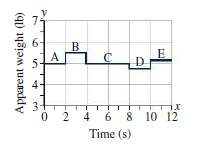
Concept explainers
Laptop computers are equipped with accelerometers that sense when the device is dropped and then put the hard drive into a protective mode. Your computer geek friend has written a program that reads the accelerometer and calculates the laptop’s apparent weight. You’re amusing yourself with this program on a long plane flight. Your laptop weighs just 5 pounds, and for a long time that’s what the program reports. But then the “Fasten Seatbelt” light comes on as the plane encounters turbulence. For the next 12 seconds, your laptop reports rapid changes in apparent weight, as shown in Fig. 4.29.

FIGURE 4.29 The laptop’s apparent weight (Passage Problems 76-79).
The plane’s vertical acceleration has its greatest magnitude
- a. during interval B.
- b. during interval C.
- c. during interval D.
Want to see the full answer?
Check out a sample textbook solution
Chapter 4 Solutions
Essential University Physics: Volume 1 (3rd Edition)
Additional Science Textbook Solutions
Organic Chemistry (8th Edition)
Biology: Life on Earth (11th Edition)
Campbell Essential Biology with Physiology (5th Edition)
College Physics: A Strategic Approach (3rd Edition)
Anatomy & Physiology (6th Edition)
Introductory Chemistry (6th Edition)
- An EL NIÑO usually results in Question 8Select one: a. less rainfall for Australia. b. warmer water in the western Pacific. c. all of the above. d. none of the above. e. more rainfall for South America.arrow_forwardA child's pogo stick (figure below) stores energy in a spring (k = 2.05 × 104 N/m). At position (✗₁ = -0.100 m), the spring compression is a maximum and the child is momentarily at rest. At position ® (x = 0), the spring is relaxed and the child is moving upward. At position child is again momentarily at rest at the top of the jump. Assume that the combined mass of child and pogo stick is 20.0 kg. B A (a) Calculate the total energy of the system if both potential energies are zero at x = 0. (b) Determine X2- m (c) Calculate the speed of the child at x = 0. m/s (d) Determine the value of x for which the kinetic energy of the system is a maximum. mm (e) Obtain the child's maximum upward speed. m/s thearrow_forwardAn EL NIÑO usually results in Question 8Select one: a. less rainfall for Australia. b. warmer water in the western Pacific. c. all of the above. d. none of the above. e. more rainfall for South America.arrow_forward
- Earth’s mantle is Question 12Select one: a. Solid b. Liquid c. Metallic d. very dense gasarrow_forwardSilicates Question 18Select one: a. All of these b. Are minerals c. Consist of tetrahedra d. Contain silicon and oxygenarrow_forwardWhich of the following is not one of the major types of metamorphism? Question 20Select one: a. Fold b. Contact c. Regional d. Sheararrow_forward
- A bungee jumper plans to bungee jump from a bridge 64.0 m above the ground. He plans to use a uniform elastic cord, tied to a harness around his body, to stop his fall at a point 6.00 m above the water. Model his body as a particle and the cord as having negligible mass and obeying Hooke's law. In a preliminary test he finds that when hanging at rest from a 5.00 m length of the cord, his body weight stretches it by 1.55 m. He will drop from rest at the point where the top end of a longer section of the cord is attached to the bridge. (a) What length of cord should he use? m (b) What maximum acceleration will he experience? m/s²arrow_forwardOne end of a light spring with spring constant k is attached to the ceiling. A second light spring is attached to the lower end, with spring constant k. An object of mass m is attached to the lower end of the second spring. (a) By how much does the pair of springs stretch? (Use the following as necessary: k₁, k₂, m, and g, the gravitational acceleration.) Xtotal (b) What is the effective spring constant of the spring system? (Use the following as necessary: k₁, k₂, m, and g, the gravitational acceleration.) Keff (c) What If? Two identical light springs with spring constant k3 are now individually hung vertically from the ceiling and attached at each end of a symmetric object, such as a rectangular block with uniform mass density. In this case, with the springs next to each other, we describe them as being in parallel. Find the effective spring constant of the pair of springs as a system in this situation in terms of k3. (Use the following as necessary: k3, M, the mass of the symmetric…arrow_forwardA object of mass 3.00 kg is subject to a force FX that varies with position as in the figure below. Fx (N) 4 3 2 1 x(m) 2 4 6 8 10 12 14 16 18 20 i (a) Find the work done by the force on the object as it moves from x = 0 to x = 5.00 m. J (b) Find the work done by the force on the object as it moves from x = 5.00 m to x = 11.0 m. ] (c) Find the work done by the force on the object as it moves from x = 11.0 m to x = 18.0 m. J (d) If the object has a speed of 0.400 m/s at x = 0, find its speed at x = 5.00 m and its speed at x speed at x = 5.00 m speed at x = 18.0 m m/s m/s = 18.0 m.arrow_forward
- A crate with a mass of 74.0 kg is pulled up an inclined surface by an attached cable, which is driven by a motor. The crate moves a distance of 70.0 m along the surface at a constant speed of 3.3 m/s. The surface is inclined at an angle of 30.0° with the horizontal. Assume friction is negligible. (a) How much work (in kJ) is required to pull the crate up the incline? kJ (b) What power (expressed in hp) must a motor have to perform this task? hparrow_forwardA deli uses an elevator to move items from one level to another. The elevator has a mass of 550 kg and moves upward with constant acceleration for 2.00 s until it reaches its cruising speed of 1.75 m/s. (Note: 1 hp (a) What is the average power (in hp) of the elevator motor during this time interval? Pave = hp (b) What is the motor power (in hp) when the elevator moves at its cruising speed? Pcruising hp = 746 W.)arrow_forwardA 1.40-kg object slides to the right on a surface having a coefficient of kinetic friction 0.250 (Figure a). The object has a speed of v₁ = 3.50 m/s when it makes contact with a light spring (Figure b) that has a force constant of 50.0 N/m. The object comes to rest after the spring has been compressed a distance d (Figure c). The object is then forced toward the left by the spring (Figure d) and continues to move in that direction beyond the spring's unstretched position. Finally, the object comes to rest a distance D to the left of the unstretched spring (Figure e). d m v=0 -D- www (a) Find the distance of compression d (in m). m (b) Find the speed v (in m/s) at the unstretched position when the object is moving to the left (Figure d). m/s (c) Find the distance D (in m) where the object comes to rest. m (d) What If? If the object becomes attached securely to the end of the spring when it makes contact, what is the new value of the distance D (in m) at which the object will come to…arrow_forward
 University Physics Volume 1PhysicsISBN:9781938168277Author:William Moebs, Samuel J. Ling, Jeff SannyPublisher:OpenStax - Rice University
University Physics Volume 1PhysicsISBN:9781938168277Author:William Moebs, Samuel J. Ling, Jeff SannyPublisher:OpenStax - Rice University Principles of Physics: A Calculus-Based TextPhysicsISBN:9781133104261Author:Raymond A. Serway, John W. JewettPublisher:Cengage Learning
Principles of Physics: A Calculus-Based TextPhysicsISBN:9781133104261Author:Raymond A. Serway, John W. JewettPublisher:Cengage Learning Physics for Scientists and Engineers: Foundations...PhysicsISBN:9781133939146Author:Katz, Debora M.Publisher:Cengage Learning
Physics for Scientists and Engineers: Foundations...PhysicsISBN:9781133939146Author:Katz, Debora M.Publisher:Cengage Learning College PhysicsPhysicsISBN:9781285737027Author:Raymond A. Serway, Chris VuillePublisher:Cengage Learning
College PhysicsPhysicsISBN:9781285737027Author:Raymond A. Serway, Chris VuillePublisher:Cengage Learning Glencoe Physics: Principles and Problems, Student...PhysicsISBN:9780078807213Author:Paul W. ZitzewitzPublisher:Glencoe/McGraw-Hill
Glencoe Physics: Principles and Problems, Student...PhysicsISBN:9780078807213Author:Paul W. ZitzewitzPublisher:Glencoe/McGraw-Hill College PhysicsPhysicsISBN:9781305952300Author:Raymond A. Serway, Chris VuillePublisher:Cengage Learning
College PhysicsPhysicsISBN:9781305952300Author:Raymond A. Serway, Chris VuillePublisher:Cengage Learning





